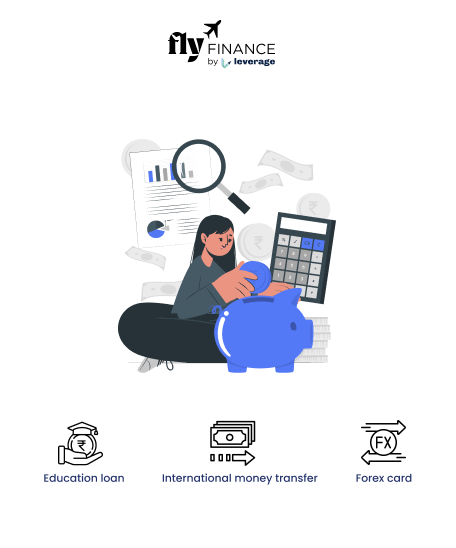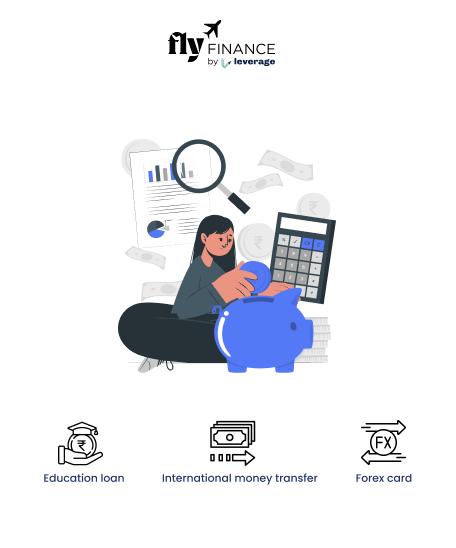The Union Budget 2023-2024, presented on February 1, 2023, by Finance Minister Nirmala Sitharaman, introduced significant changes to the Tax Collected at Source (TCS) on foreign remittances under the Liberalised Remittance Scheme (LRS). For Indian students planning to study abroad, understanding the TCS on foreign remittances for education is crucial for financial planning.
This blog provides a comprehensive guide to the TCS on foreign remittance for education section, latest TCS regulations, their implications for education-related remittances, and actionable tips to optimize your study abroad budget. Read on to make informed decisions about university fees, accommodation, and other expenses!
Table of contents
- What is Foreign Remittance?
- What is Liberalised Remittance Scheme (LRS)?
- What is TCS on Foreign Remittance for Education?
- Latest Budget Updates on TCS for Education Remittances
- Challenges with Living Expenses
- How to Minimize TCS on Education Remittances
- How TCS Affects Study Abroad Planning
- Tips for Students and Parents
- FAQs on TCS on Foreign Remittance for Education Section
What is Foreign Remittance?
Foreign remittance refers to the transfer of money from India to another country (outward remittance) or from abroad to India (inward remittance). Outward remittances, such as parents sending money to their children studying abroad, fall under the Reserve Bank of India’s (RBI) Liberalised Remittance Scheme (LRS) and are subject to TCS. These transactions contribute to India’s economy, with a portion of the funds taxed to support national growth.
Types of Foreign Remittance
- Inward Remittance: Money received in India from non-residents abroad, e.g., family members receiving funds from NRIs.
- Outward Remittance: Money sent from India to another country, e.g., parents funding their child’s education abroad.
What is Liberalised Remittance Scheme (LRS)?
The Liberalised Remittance Scheme, established by the RBI, allows Indian residents to remit up to USD 250,000 per financial year for permissible purposes without prior RBI approval. These purposes include:
- Education abroad
- Medical treatment
- Family maintenance
- Foreign investments
- Donations and gifts
However, activities such as trading in foreign goods under Schedule II of the Foreign Exchange Management Rules, 2000, are prohibited. All outward remittances under LRS are subject to TCS as per Section 206C(1G) of the Income Tax Act, with specific rates and thresholds depending on the purpose.
What is TCS on Foreign Remittance for Education?
Tax Collected at Source (TCS) is a tax levied by banks or authorized dealers on outward remittances under LRS, effective since October 1, 2020. For education-related remittances, TCS applies when the remitted amount exceeds INR 7 lakh per financial year (until Budget 2025, after which the threshold increased to INR 10 lakh). The TCS rate varies based on the funding source:
- Education Loan: 0.5% TCS on amounts exceeding INR 7 lakh (or INR 10 lakh post-Budget 2025) if the loan is from a financial institution covered under Section 80E of the Income Tax Act.
- Personal Funds: 5% TCS on amounts exceeding INR 7 lakh (or INR 10 lakh post-Budget 2025) for education expenses not funded by an education loan.
TCS is not an additional cost but an advance tax payment, which can be adjusted against your tax liability or claimed as a refund when filing your Income Tax Return (ITR).
Also Read: How Foreign Remittance Works? Know How to Remit Money
Latest Budget Updates on TCS for Education Remittances
The Union Budget 2023-2024 introduced changes to TCS rates for foreign remittances, effective from October 1, 2023. For education remittances, the rates remain favorable compared to other purposes, which saw a hike to 20% for amounts exceeding INR 7 lakh. The Budget 2025 further refined these rules, increasing the TCS threshold to INR 10 lakh and introducing exemptions for certain education-related remittances.
Current TCS Rates
| Purpose | TCS Rate | Threshold (Pre-Budget 2025) | Threshold (Post-Budget 2025) |
|---|---|---|---|
| Education via Loan (Section 80E) | 0.5% | Above INR 7 lakh | Above INR 10 lakh |
| Education via Personal Funds | 5% | Above INR 7 lakh | Above INR 10 lakh |
Budget 2025 Updates
- Increased Threshold: The TCS threshold for LRS remittances, including education, was raised from INR 7 lakh to INR 10 lakh per financial year, effective April 1, 2025. Remittances up to INR 10 lakh are now TCS-free.
- Exemption for Education Loans: No TCS applies to education remittances funded by loans from specified financial institutions, regardless of the amount, as announced in Budget 2025.
- Living Expenses Clarification: Remittances for living expenses linked to education (e.g., hostel fees) attract 5% TCS if the educational purpose is established. If not, a 20% TCS may apply, especially for off-campus accommodation like private apartments.
Challenges with Living Expenses
A key challenge for parents funding education abroad is distinguishing between education-related and non-education-related living expenses. For example:
- On-Campus Accommodation: Payments for university hostels are clearly linked to education and attract 5% TCS (above the threshold).
- Off-Campus Accommodation: Funding private apartments may be scrutinized, and if not proven to be education-related, a 20% TCS could apply. To minimize this risk, opt for university-provided accommodation or ensure documentation links the expense to education.
How to Minimize TCS on Education Remittances
To optimize your study abroad budget and reduce the TCS burden, consider these strategies:
- Stay Below the Threshold: Keep total remittances below INR 10 lakh per financial year to avoid TCS entirely.
- Use Education Loans: Fund education through loans from financial institutions covered under Section 80E to benefit from the 0.5% TCS rate (or 0% post-Budget 2025).
- Choose Credit Cards: Payments for education fees via international credit cards are exempt from TCS, though be mindful of transaction fees.
- Plan Remittances: Spread remittances across financial years or among family members to stay below the threshold.
- Document Expenses: Maintain clear documentation linking living expenses to education (e.g., university invoices) to avoid the 20% TCS rate.
- Claim Refunds: File your ITR to claim TCS as a credit or refund if your tax liability is lower than the TCS paid.
How TCS Affects Study Abroad Planning
The TCS regulations impact the cost of studying abroad, particularly for high-value remittances. For example, remitting INR 12 lakh for tuition fees using personal funds incurs 5% TCS on INR 2 lakh (INR 10,000) post-Budget 2025. This amount is withheld by the bank and reflected in your Form 26AS, allowing you to claim it back during ITR filing. However, the upfront cash flow impact can strain budgets, making strategic planning essential.
Also Read: Remittance in Foreign Currency: Check All Details Here
Tips for Students and Parents
- Choose Universities Wisely: Opt for institutions with transparent fee structures and on-campus housing to simplify TCS compliance.
- Consult a Tax Advisor: Work with a professional to ensure accurate documentation and maximize TCS refunds.
- Use Wise for Transfers: Services like Wise offer transparent fees and mid-market exchange rates, reducing the overall cost of remittances.
FAQs on TCS on Foreign Remittance for Education Section
The Tax Collected at Source (TCS) on foreign remittances for education depends on the funding source and applies to amounts exceeding INR 7 lakh (INR 10 lakh post-Budget 2025, effective April 1, 2025):
Education Loan: 0.5% TCS for remittances above INR 7 lakh (or INR 10 lakh post-Budget 2025) if funded by a loan from a financial institution under Section 80E of the Income Tax Act. Budget 2025 exempts such remittances from TCS entirely.
Personal Funds: 5% TCS for remittances above INR 7 lakh (or INR 10 lakh post-Budget 2025) for education expenses, such as tuition or living costs, not funded by an education loan.
Note: TCS is adjustable against your tax liability or refundable when filing your Income Tax Return (ITR).
TCS on foreign remittances under the Liberalised Remittance Scheme (LRS) is governed by Section 206C(1G) of the Income Tax Act. This section mandates banks and authorized dealers to collect TCS on outward remittances, including education, medical treatment, and investments, to track foreign transactions and ensure tax compliance.
Yes, TCS applies to education fees remitted under LRS when the total amount exceeds INR 7 lakh per financial year (INR 10 lakh post-Budget 2025). The applicable rates are:
0.5% for fees funded by an education loan (or 0% post-Budget 2025).
5% for fees paid using personal funds.
Tip: Pay fees via international credit cards to avoid TCS, but check for transaction charges. Maintain documentation to link remittances to education for compliance.
Tax Collected at Source (TCS) on foreign remittances for education is an advance tax that can be claimed as a credit or refunded when filing your Income Tax Return (ITR). To claim a refund:
Check Form 26AS: Ensure the TCS amount appears in your Form 26AS, reflecting the tax collected by the bank.
File ITR: Report the TCS under the appropriate section of your ITR form and adjust it against your tax liability.
Submit Documentation: Provide remittance details (e.g., bank statements, university invoices) if required by the tax authorities.
If your total tax liability is lower than the TCS paid, the excess is refunded. Consult a tax advisor for accurate filing.
Yes, TCS applies to living expenses remitted under the Liberalised Remittance Scheme (LRS) if they exceed INR 7 lakh (INR 10 lakh post-Budget 2025:
Education-Linked Expenses: Expenses like university hostel fees attract 5% TCS if clearly documented as education-related.
Non-Education Expenses: Off-campus accommodation (e.g., private apartments) may incur 20% TCS if not linked to education.
You can minimize or avoid TCS on foreign remittances for education by:
Staying Below the Threshold: Keep remittances under INR 7 lakh (INR 10 lakh post-Budget 2025) per financial year.
Using Education Loans: Loans from institutions under Section 80E qualify for 0.5% TCS (or 0% post-Budget 2025).
Paying via Credit Cards: Education fee payments through international credit cards are TCS-exempt, though transaction fees may apply.
Spreading Remittances: Split transfers across family members or financial years to stay below the threshold.
The Union Budget 2025, effective April 1, 2025, introduced key changes to TCS on foreign remittances for education:
Increased Threshold: The TCS exemption limit rose from INR 7 lakh to INR 10 lakh per financial year.
Education Loan Exemption: Remittances funded by loans from financial institutions under Section 80E are now TCS-free, regardless of the amount.
Living Expenses Clarification: Education-related living expenses (e.g., hostel fees) remain at 5% TCS, while non-education expenses may face 20% TCS.
TCS on foreign remittances under LRS, including education, is collected by:
Banks: When you transfer funds through a bank for tuition or living expenses.
Authorized Dealers: Foreign exchange dealers or money transfer services (e.g., Wise) authorized by the RBI.
That was all about the latest TCS on Foreign Remittance in Education Section! Continue reading Fly Finance for everything related to study abroad finances!





























